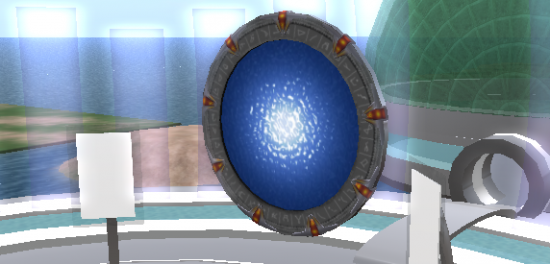The OpenSim community is currently in the process of upgrading to Hypergrid 1.5, a more secure version of the hypergrid protocol that allows teleportation between different grids.
However, Hypergrid 1.5 isn’t compatible with the previous Hypergrid 1.0 standard, according to hypergrid inventor Crista Lopes, professor of informatics at the University of California, Irvine.

This means that teleports between grids running on different versions will fail. This will cause hypergrid travel problems and inconvenience for hypergrid users until all grids upgrade to the new platform.

“Hypergrid 1.0 and 1.5 are totally and bidirectionally incompatible. No teleports, no mapping,” confirmed OpenSim core developer Melanie Thielker, who is also the CEO of OpenSim hosting company 3D Hosting.
As a result, most major grids are waiting before switching over to the new standard. Most public hypergrid-enabled grids are waiting to see when OSGrid, the largest OpenSim-based grid, switches over to Hypergrid 1.5, which requires OpenSim version 0.7 or higher.
According to OSGrid administrator David Coyle, OSGrid will begin testing version 0.7 in August.
“We don’t yet have a date for the eventual migration,” he added.
Until then, the grid will be running version 0.6.9, he said.
“As OSGrid still recommends the 0.6.9-postfix version, we will stay with that version, too,” said Kai Ludwig, owner and manager of the Wilder Westen and Open Neuland grids and CEO of OpenSim hosting company TalentRaspel virtual worlds Ltd. Wilder Westen is currently hypergrid-enabled, running Hypergrid 1.0, and half of all visitors arrive via hypergrid teleports. Open Neuland is currently not on the hypergrid — all visitors have to create new accounts and log in directly.
Upgrading too early would eliminate the possibility of travel to and from OSGrid, he said.
According to the latest OpenSim grid statistics, OSGrid currently accounts for about as many active users as all other large public grids combined.

OSGrid also has a sizable population of testers and developers, Ludwig added. That means that they can test out the new 0.7 release in depth and get any early bugs caught and fixed.
“So we will wait and move two weeks after OSGrid does,” Ludwig said.
He’s not alone. Many public grids are warning their users not to upgrade their regions too soon.
“If you upgrade … you will be cutting yourself off from the majority of the hypergrid,” warned Kidd Piko, grid manager for Stamina Grid and the maker of The Hypergates hypergrid teleportation network. “You will not be able to teleport to most of the other grids and standalones that are using hypergrid, and most of them will not be able to teleport to you.”
To deal with the compatibility issues, The Hypergates will temporary suspend all listings for grids and regions running Hypergrid 1.5, Piko said. The listings will be reinstated again once the majority of grids switch over to Hypergrid 1.5.
The education and business-focused ReactionGrid is also holding off on rolling out Hypergrid 1.5.

“I’m looking forward to trying it when I can next build a compatible version of OpenSim,” said ReactionGrid CTO Chris Hart. “But we’ve only just moved to OpenSim 0.6.9 and we don’t intend on moving further at this stage until things are nice and stable and until such time as there is a compelling reason to move on. There are significant requirements in running 0.7 in terms of administration interfaces, and several core database schema changes that make moving forward a lot more work than ever before.”
ReactionGrid currently operates a publicly-accessible grid of the same name, with 148 regions and around 5,500 registered users and 400 active users. The company also manages 50 private grids for its corporate and education clients, with hypergrid teleports allowing travel between these grids.
“We are promoting hypergrid between our client grids and helping our teachers set that up and all seem very happy with it at present,” Hart said.
However, some cutting-edge grids are already making the jump to Hypergrid 1.5.
DWGrid manager Dolma Dollinger, for example, upgraded her grid in late June.
“So I am temporarily off the normal hypergrid until it catches up,” she said.
SECURITY IN A SUITCASE
Hypergrid 1.5 makes cross-grid travel more secure by locking down avatar inventories — all the virtual stuff that travelers own — except for one folder called “My Suitcase.” Previously, travelers could access their entire inventories while on a foreign grid. And, in theory, so could the foreign grid owners. There have been no reported cases, however, of rogue grid owners hijacking the assets of hypergrid visitors.
With the new upgrade, users can still access their inventories while on a foreign grid, but the foreign grid owners can only see those assets when the users do, and can only directly access the “My Suitcase” folder.

“By accessing inventory items in your inventory, you are disclosing them to the simulator where you are,” Lopes told Hypergrid Business. “A rogue simulator can then copy them.”
Lopes recommended that users only access their inventories on trustworthy grids. If users never access their inventories while traveling, then those inventories are completely protected, she said.
Similarly, if users take an object from a foreign grid, they can put it anywhere in your inventory that they like. But all objects that are given to them are put in the “My Suitcase” folder.
“Again, it is advisable that you only ‘take’ objects from grids that you trust,” Lopes said.
Unwanted objects may contain spam or rogue scripts that cause trouble when those objects are placed on the ground or worn — or “rezzed.”
The biggest advantage of Hypegrid 1.5 is that the foreign grid only has access to inventory items that the users request — which means that nobody can go in and delete other items.
“Inventory is now completely protected from malicious deletions,” she said.
Lopes added that these security measures may seem confusing, but are currently the best available solution.
OpenSim developers have no access to the viewer software. This is partly due to license issues, and partly due to the fact that many OpenSim users access their OpenSim grids by using one of the official Second Life viewers. The third-party viewers are developed under a license incompatible with the OpenSim software — a developer can not work on both projects at once. There is no OpenSim-specific viewer currently available.
The good part of this is that users get to use software that they already know and understand, without having to dowload a special viewer just for OpenSim. And the reliance on the Second Life viewers means that OpenSim maintains a certain amount of compatiblity with Second Life, allowing objects and scripts to be moved back and forth. This means that content producers can make and store their content in OpenSim and sell it in Second Life, and that users can go to Second Life for training in building and scripting skills.
The downside to this is that OpenSim is limited to some degree by Second Life’s security architecture. For example, all Second Life regions are run by Linden Lab — there are no potentially “rogue regions” or “rogue grids” for their users to visit. As a result, there was no need for Second Life to build heavy-duty security into its viewers.
“While we don’t have viewers that access inventory differently, this compromise is the best we can do,” Lopes said.
Hypergrid 1.5 is expected to significantly increase the number of grids that allow hypergrid teleports in and out.
Most major public grids — including OSGrid and ReactionGrid — are already hypergrid-enabled, and the number is growing steadily. (List of currently active hypergrid-enabled grids is here.)
There are three main reasons why the other grids aren’t opening up access, however, only one of which is addressed by the new Hypergrid 1.5 protocol. Grid managers are worried that their residents may lose inventory items while traveling off-grid, that unauthorized people will teleport into the grid and cause mischief, and that users will take proprietary content from the grid and distribute it on other grids.
Content theft by stealing inventory items from unsuspecting travelers — the security threat that Hypergrid 1.5 address — is not a real threat but a theoretical one, said Wilder Westen and Open Neuland’s Ludwig. Even with the insecure Hypergrid 1.0, it would take a lot of effort on the part of a rogue grid owner to entice visitors to teleport in, and then to steal their belongings. Not to mention having then to comb through those belonging to see if there was anything valuable in there.
“If you wish to hack or steal content, there are much easier ways,†Ludwig said. Hackers with the technical skills to set up their own grids, wait for visitors, and hijack their inventories have many other options, he said, which are much faster and more effective. He provided some examples, which we’re not going to list here, to avoid giving anybody any ideas.
Users deliberately taking content is a more significant problem, that Hypergrid 1.5 will not be able to address. Content theft is a problem on all grids, including Second Life. When users have access to asset databases — which they do if they run their own regions or their own grids — they can then copy items for which they do not have copy permission, or modify “no-modify” items. With some hacking skills, they can also change the creators listed for these items, making it possible for them to re-sell or distribute them. Simple, unscripted items are the most difficult to protect. Scripted items can be protected by having the script running on the server, instead of in the simulator. Another approach is to make buying a legitimate version of the item easy and inexpensive, so that restrictive digital rights management measures aren’t needed — similar to the way that iTunes sells DRM-free music.
Meanwhile, Wilder Westen and Open Neuland’s Ludwig is getting ready for Hypergrid 1.5.
“Our test system is running [OpenSim] 0.7.1 dev and it is working fine and stable,” he said. “We worked out all the migration issues, adapted our additional software, and have a list of upgrade steps ready. So we are ready to go.”
And it won’t just be Wilder Westen — which is already on the hypergrid — that will be switching over, he added.
“We will enable Open Neuland for hypergrid, too,” he said. However, some regions will remain restricted to grid residents. “Some Wilder Westen and some Open Neuland regions will be blocked from hypergrid access, as their owners only want visitors that have registered themselves in our database. All other regions will be fully hypergrid-enabled.”
Offering partial hypergrid access solves the final security obstacle to widespread hypergrid adoption.
LIMITING ACCESS
By having some areas of a grid hypergrid-enabled, and others restricted to registered residents only, a grid can have the best of both worlds. Having private areas allows grid administrators to kick off residents who violate its terms of service, for example. Public, hypergrid-accessible areas allow registered grid residents to mix with the general public — while feeling safe that strangers aren’t going to follow them back to their homes. And they also allow residents to travel off-grid — for shopping, for meetings, or for socializing with friends on other worlds.
There are several other reasons why grids may want to have some regions off-limits to hypergrid travelers as well.
Paywalls. Just as some websites have “members only” sections that are available only to paying members, grid owners can charge for memberships, and put the premium content in areas of the grid off-limits to casual visitors.
Adult areas. Anybody can hypergrid teleport in. If a grid has adult content, local laws may require that grid owners verify the ages of all visitors. By segregating adult content to non-hypergrid regions, grid owners can allow the public to teleport in and get a taste of what the grid has to offer without going to the trouble of registering and creating a new avatar.
Employee areas. A company-owned grid is likely to have some private content that needs to be accessible only to company employees. But a company may also want to hold public marketing conferences and other promotional events, conduct training sessions for customers, and meet with sales reps and business colleagues at other firms.
Student areas. An elementary school isn’t likely to want to allow its students to travel the wider hypergrid unsupervised. But a college running an education grid may be ready to open up its doors. Hypergrid access would allow students and faculty members from different colleges to visit one another’s grids and attend public lectures. Prospective students can use the public areas to tour the campus virtually before visiting in person and get familiar with the campus layout. However, actual classrooms could be restricted to enrolled students with accounts on the grid.
- Analysts predict drop in headset sales this year - March 25, 2025
- OSgrid enters immediate long-term maintenance - March 5, 2025
- OSgrid wiping its database on March 21: You have five weeks to save your stuff - February 15, 2025
